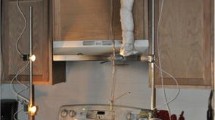Abstract
Incorporating intelligence into a fire detector so that it can recognize signature patterns is intended to permit prompt fire detection while allowing the detector to discriminate between signatures from fire and nonfire sources. The primary purpose of this preliminary study is to investigate the patterns of signatures associated with fire and environmental sources using small-scale experiments. We generated products from a wide range of conditions, from flaming or pyrolyzing samples, to heated samples and samples obtained with an atomizer. We also measured gas concentrations, light obscuration, and temperature to characterize the products. By analyzing the data, we identified trends from which an elementary expert system can be formulated to identify the source of the airborne products. Several patterns are evident. The maximum CO2 concentrations achieved during experiments with flaming fires are significantly greater than the maximum CO2 concentrations achieved during experiments with nonflaming fires (pyrolyzing fires, heated liquids, and environmental odors). The nonflaming sources can be identified based on the CO and metal oxide sensor peak measurements. Except for three experiments using pyrolyzing solids, the peak CO concentration is greater—though the Taguchi detector response is less—for nonflaming fires than for environmental sources. Subsequent application of a neural network properly classifies all except one pyrolyzing fire.
Similar content being viewed by others
References
Shurmer, H. V., and Gardner, J. W., “Odour Discrimination with an Electronic Nose,”Sensors and Actuators B, 1992, pp. 1 to 11.
Bryan, J. L., “Behavioral Response to Fire and Smoke,”SFPE Handbook of Fire Protection Engineering, P.J. DiNenno, ed., National Fire Protection Association, Quincy, Mass., 1988.
Hall, J. R., “The Latest Statistics on U.S. Home Smoke Detectors,”Fire Journal, Volume 83, Number 1 (January 1989), pp. 39 to 41.
Von Tomkewitsch, R., “Fire Detector Systems with ‘Distributed Intelligence:’ The Pulse Polling System,”Fire Safety Journal, Volume 6, 1983, pp. 225 to 231.
Scheidweiler, A., “The Distribution of Intelligence in Future Fire Detection Systems,”Fire Safety Journal, Volume 6, 1983, pp. 209 to 214.
Ishii, H., Ono, T., Yamauchi, Y., and Ohtani, S., “An Algorithm for Improving the Reliability of Detection with Processing of Multiple Sensors' Signal,”Fire Safety Journal, Volume 17, 1991, pp. 469 to 484.
Bukowski, R. W., and O'Laughlin, R. O.,Fire Alarm Signaling Systems, National Fire Protection Association, Quincy, Mass., 1994.
Thuillard, M., “New Methods for Reducing the Number of False Alarms in Fire Detection Systems,”Fire Technology, Volume 30, Number 2 (Second Quarter 1994), pp. 250 to 268.
Grosshandler, W. L.,An Assessment of Technologies for Advanced Fire Detection, National Institute of Standards and Technology, Gaithersburg, Md., 1992.
Jackson, M. A., and Robins, I., “Gas Sensing for Fire Detection: Measurements of CO, CO2, H2, O2 and Smoke Density in European Standard Fire Tests,”Fire Safety Journal, Volume 23, 1994, pp. 181 to 205.
Gardner, J. W., Shurmer, H. V. and Tan, T. T., “Application of an Electronic Nose to the Discrimination of Coffees,”Sensors and Actuators B, Volume 6, 1992, pp. 71 to 75.
Okayama, Y., “Approach to Detection of Fires in Their Very Early Stage by Odor Sensors and Neural Net,”Proceedings of the Third International Symposium of Fire Safety Science, 1991, pp. 955 to 964.
Okayama, Y., Ito, T., and Sasaki, T., “Design of Neural Net to Detect Early Stage of Fires and Evaluation by Using Real Sensors' Data,”Proceedings of the 4th International Symposium on Fire Safety Science, Ottawa, 1994, pp. 751 to 759.
Ishii, H., Ono, T., Yamauchi, Y., and Ohtani, S., “Fire Detection System by Multi-Layered Network with Delay Circuit,”Proceedings of the 4th International Symposium on Fire Safety Science, Ottawa, 1994, pp. 761 to 772.
Gardner, J. W. and Bartlett, P. N., “Pattern Recognition in Gas Sensing,"Techniques and Mechanisms in Gas Sensing, Hilger, Bristol, England, 1991.
Tewarson, A., "Generation of Heat and Chemical Compounds in Fires,”SFPE Handbook of Fire Protection Engineering, P.J. DiNenno, ed., National Fire Protection Association, Quincy, Mass., 1988.
Denny, S., “Development of a Discriminating Fire Detector for Use in Residential Occupancies,”Report FP 93-07, M.S. thesis, University of Maryland, December 1993.
UL 217,Single- and Multiple-Station Smoke Detectors, Underwriters Laboratories, Northbrook, Ill., 1985.
Pan, D., “Applications of Pattern Recognition Using Neural Networks,” M.S. thesis, University of Maryland, 1994.
Kavuri, S. N., and Venkatasubramanian, V., “Using Fuzzy Clustering and Ellipsoidal Units for Fault Classification,”Computers and Chemical Engineering, Volume 17, Number 8, August 1993, pp. 765 to 784.
Bukowski, R. W. and Bright, R. G., “Taguchi Semiconductor Gas Sensors as Residential Fire/Smoke Detection,”Fire Journal, Volume 69, Number 3, May 1975, pp. 30 to 33.
Author information
Authors and Affiliations
Rights and permissions
About this article
Cite this article
Milke, J.A., McAvoy, T.J. Analysis of signature patterns for discriminating fire detection with multiple sensors. Fire Technol 31, 120–136 (1995). https://doi.org/10.1007/BF01040709
Issue Date:
DOI: https://doi.org/10.1007/BF01040709




